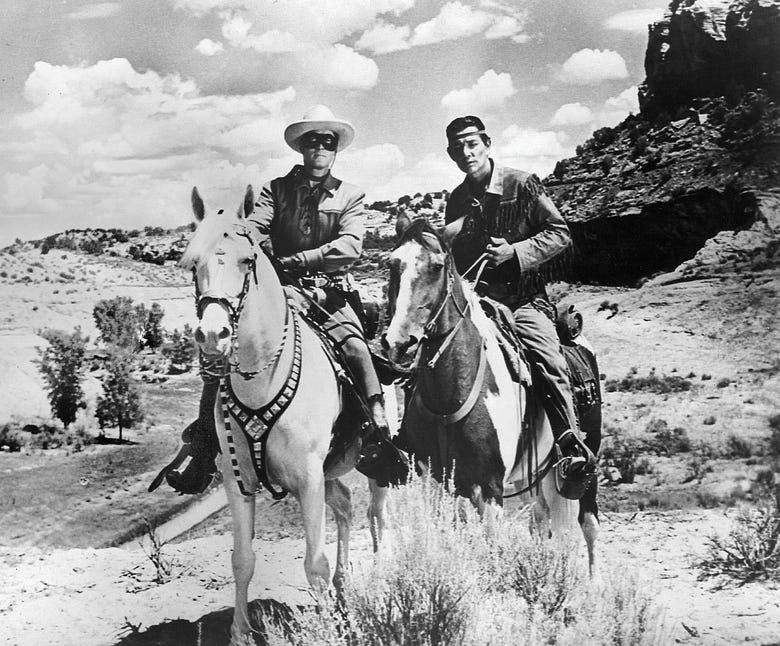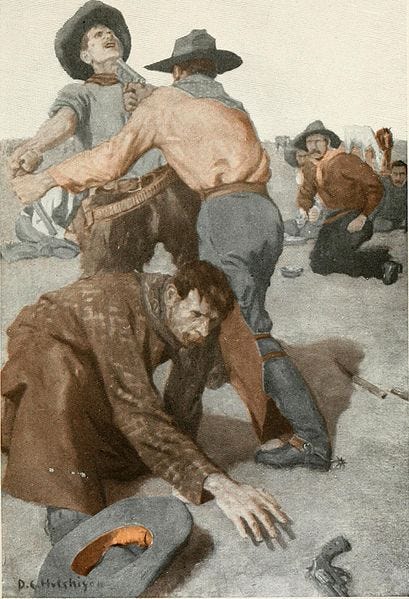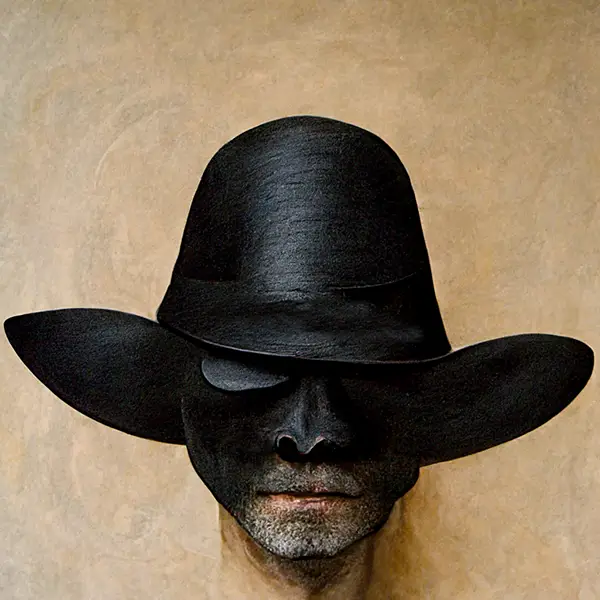
“Hi-Ho, Silver, blast away!”
The noble white horse. The characteristic silver bullets. The racist trope of a sidekick. Most of us remember The Lone Ranger as a rule-stretching, right-from-wrong-having, justice-always-prevails Texas cowboy with a badge.
But if he was based on reality, he probably would’ve been more famous for his bloodlust, torturous ways, and genocide.
The Lone Ranger Origin Story
Back in 1932, the Great Depression was at its lowest point. Prohibition was ruining people’s fun throughout the country.
People were sad, mad, and definitely not glad.
Detroit’s famous WXYZ radio station wanted to do something about this. They decided they were in need of a new kind of radio series. The people needed a new hero. One that could inspire and teach right from wrong. One who could remind people to remember their ethics in a time of mass poverty and alcohol-free bars.
And Fran Stalker was just the writer for the job.
He had already been selling up to five stories a week to the radio station for quite some time. He answered the call, drafted a creative backstory about a single Texas Ranger surviving a surprise raid where all his compatriots died — and out popped The Lone Ranger.
Next came countless radio shows, television episodes, comic books, comic strips, and movies, culminating in an almost embarrassing effort by the now heavily embattled/stained/tainted Johnny Depp.
America now looks fondly upon the tale of Texas Rangers. An organization canceled more often than Charlie Sheen, and yet still exists today with 166 commissioned members as a unique form of state bureau of investigation.
All’s well that ends well, right?
Not so fast there, pilgrim.
The Real Texas Rangers
The original Texas Rangers were formed way back in 1823 by the so-called “Father of Texas,” Stephen F. Austin. He was a man with a mission — to turn the rebellious state of Mexican Texas into the next biggest state of the USA.

To get this annexation rolling, he aided around 300 American families to settle into the territory. And as usual — when people try to invade others’ land — the preexisting locals weren’t too happy about it.
They raided. They fought. They killed. They protected their land, in their own way.
So Mr. Austin (ever heard of Austin, Texas?) put together a small band of 10 ruffians, gave them a fancy name, and put them to work on protection duty.
Protection for illegal settlers, that is.
13 years later after, just before Texas declared itself a republic (separate from Mexico and the US), the Texas Rangers were officially recognized and formed as a group of law enforcement officials.
The next 60 odd years were full of great heroic deeds protecting innocent settlers from evil Mexicans and Native American forces trying to disturb their way of life.
At least, that’s what I would write if I were an American journalist during that time period. The non-USA-ians might’ve felt slightly different, of course.
The time period involved absolute brutality committed on both sides. Gun battles, torture, and executions were par for the course. Except one side wore a badge and one was fighting for their stolen homeland.
And as we all know, history is written by the victors.
But these atrocities on the side of the ‘law’ were the main reason the group was disbanded time after time, only to be repeatedly reinstated whenever a new friendly government official was elected.
This occurred so many times the state actually mandated it in the 1930s to be a permanent force. One that cannot be legally disbanded according to statute.
The Forgotten Period
Then came the turn of the century and the group modernized their morals, ethics, and code of conduct. Oops, that had to wait another couple decades.
Two decades that really pushed the limits of what law enforcement could call anything close to a code of ethics. If your code of ethics included enforcing genocide, that is.
In the early 1900s, the border between Texas and Mexico was fraught with conflict. Bands of raiders would repeatedly cross the border and commit murder and wreak mayhem. A lack of federal troops on the vast territory made the problem all the bigger.
The leaders of Texas felt the only way to solve the problem was to hire hundreds of more Rangers, almost always without a vetting process. Basically, legalized and empowered criminals.
Their deeds weren’t all bad during this period, though. They prevented the assassination of both the US and Mexican presidents during a historic meeting in 1909.
But things went downhill from there. Fast.
Reports of torture, random killings and outright execution were starting to become rampant during the 1910s. Officials were mostly ignoring these efforts as they felt the Rangers still served a vital, but racist, purpose — protection of their lands against everyone who wasn’t white.
Then came 1918 and something unspeakable happened.
A popular ranch was raided by bandits on Christmas Day of 1917. How did bandits celebrate back then?
By slitting throats, hanging a mailman, and killing any witnesses. 3 people were murdered, including 2 Mexicans. The bandits made away with thousands of dollars of goods and horses before escaping back to Mexico with the U.S. Cavalry in hot pursuit.
A few weeks later, a team of Texas Rangers supplemented by a few cavalry members and white jolly ranchers (a terrible flavor) went to a local village called Porvenir, a small town inside Texas.
They went to every single home and took out every single male in the village while searching for weapons. They arrested a few people and brought them back for extra questioning.
The next morning, the Rangers went back to the village and forced everyone out of their homes and into the streets.
They summarily executed every single male who wasn’t in his teens or older. 15 males of Mexican descent who had absolutely nothing to do with the initial raid.
The town members, in unspeakable shock, took their fallen family members and moved back across the border into Mexico. The Rangers later came back and scorched the entire town, trying to erase their terrible misdeeds.
Los Diablos Tejanos (The Texan Devils)

Even the government couldn’t ignore this atrocity. Texas State Representative José Tomás (J.T.) Canales started the Canales Investigation into the Rangers’ conduct.
It’s discovery?
That somewhere in the range of up to 5,000 people — almost all of Mexican descent — had been murdered by Texas Rangers in the short period of 1910 to 1919.
I guess they must have been resisting arrest, right?
The aftermath was swift but not far-reaching:
- Firstly, they greatly reduced the size of the force to 45 members from the nearly 1,000 it was before.
- They instituted a complaint system, for those who could apparently speak from the grave.
- They drastically increased the recruiting standard for new members, to stop the common practice of hiring literal criminals.
They also gave them a substantial raise.
Wow.
In the end, the investigation committee absolved the Texas Rangers of wrongdoing. As morally incomprehensible as that was, they also commended the force’s General Harley, saying he was:
“entitled to the commendation of the Senate and House for the able, efficient, impartial, and fearless manner in which he has discharged the duties placed upon him.”
If that isn’t justice, I don’t know what is.
Oh, wait, yes I do. It isn’t that.
At all.
Back to the Lone Ranger
As for the Lone Ranger, some of you might be thinking the time period was off. While the radio/tv show had a history of blending different time periods together, most seem to think it occurred somewhere in the range of 1860 to 1900.
But on the other hand, many people credit the Lone Ranger as being based on a man by the name of John R. Hughes.

When he was 14 years old, he lived with several Native American tribes and learned their language. When he was 31, in 1886, he tracked down and killed 2 men who stole his neighbor’s horses. He was recruited to the Texas Rangers a short time later.
His career was full of danger, excitement, and you guessed it — murder! His most infamous incident involved tracking down an alleged Mexican crime family after they murdered one of his fellow Rangers.
He led a team for many long days and nights and mistakenly crossed over into Mexico at one point. It’s here where they found their list of 18 suspects, all members of the Olguin crime family.
18 suspects who soon found themselves dead by hanging or from a shootout with Hughes and his band.
His reputation alone scared off bandits if they knew he’d be around. Hughes shot first and thought later. He was the spirit of the culture that became the Texas Rangers during that time period.
He ended up retiring in 1915, just in the middle of the many atrocities being committed. I’d argue the possibly most famous Ranger of all time probably had a massive effect on the culture of the lawmen.
And if that’s true, then the Lone Ranger should be anything but praised. He should be condemned to the often forgotten murderous history of our past.
But instead, our Lone Ranger — John R. Hughes — later received the Certificate of Valor and was placed in the Texas Rangers Hall of Fame as thanks for all of his “great” deeds.
But I’m not surprised.
History is written by the victors.
J.J. Pryor
Want more fun stories? Join Pryor Thoughts for free today!
You might also be interested in reading about how the nazis hunted witches for 9 years.


